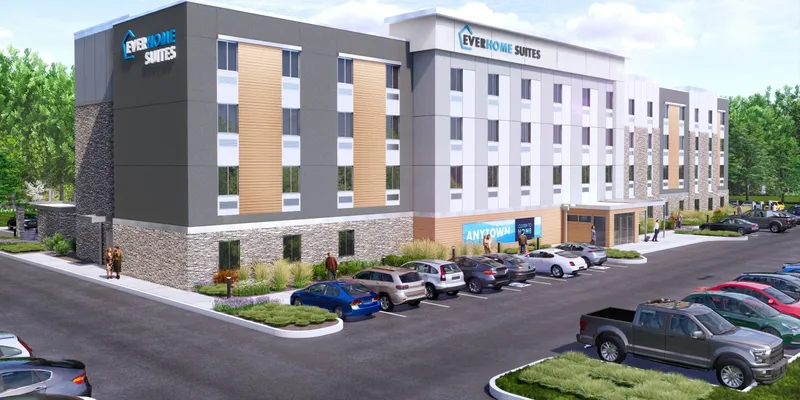Performance, value and profits: The fundamentals driving extended-stay’s dominance

Sector specialists participating in an exclusive extended-stay roundtable checklisted the reasons this formerly niche hotel sector bested recession and a pandemic and how owners can capitalize on the robust upside ahead.
No hotel sector has proven to be bullet-proof. But the extended-stay segment comes close. For more than two decades, this complex, clearly targeted niche concept demonstrated not only its durable appeal but also its rain-or-shine ROI-generating capabilities.
Owners, investors and developers confident enough to back this reimagined hotel-apartment hybrid over the last 20 years were repaid with occupancies that averaged 10% to 14% above industry-wide metrics along with similar RevPAR premiums, according to research by The Highland Group.
Far from derailing extended-stay momentum, Covid showcased the sector’s consistency and resiliency, especially in the economy end of the segment. Its core market of healthcare providers, construction crews, infrastructure teams and families with extended-stay needs logged the best performance of 2020, according to The Highland Group: a mere 0.6% decline in demand versus nearly 36% across the hotel industry and a minimal 3.1% retreat in revenue, as opposed to the nearly 50% drop for hotels overall.
Those results pushed midscale and economy extended-stay flags into the spotlight, drawing the attention of prospective owners and lenders as well as sparking more than a half-dozen major brand launches in less than a year.
Faced with the current economic uncertainty, that trend is unlikely to slow down anytime soon. A panel of experts participating in an exclusive roundtable on the drivers, demand and deliverables of this hot sector examined the opportunities ahead and how the hospitality investment community can capture that potential.
Contributing insights to this timely discussion held virtually June 29, 2023, were:
• Jim Darter, president and CEO, Sandpiper Hospitality
• Dave Martin, CEO, Hotel Management & Consulting
• Ian McClure, CEO, Gulf Coast Hotel Management
• Simon Mendy, divisional president, select service, Aimbridge Hospitality
• Anna Scozzafava, senior vice president and general manager, extended-stay, Choice Hotels
• Mark Skinner, partner, The Highland Group
• Chris Stevens, president, New Era Development
Growth opportunities
Even with the influx of new brands, economy and midscale extended-stay inventories are far from overbuilt.\
Mark Skinner on growth, opportunities: Watch video here.
Conversions are another hot topic for extended-stay owners. “Given the cost of construction, and capital, the conversion market really picking up,” said Scozzafava. “So we introduced our ‘kitchen in a box’ which enables you to take a transient hotel, put a kitchen in it and convert it into an extended stay asset. That’s been a really great entry point. We’ve got more than 20 of them under way right now with our Suburban Studios brand. There are a lot of underserved markets with extended-stay demand profiles that have good assets in them that potentially want to be more profitable and enter into the extended segment.”
Older assets that may be transitioning from extend-stay properties to apartments may afford market opportunities for additional flags, said Mendy.
Performance expectations
While the extended-stay model discounts rates with length of stay, said Mendy, the sector tends to lead in occupancy index, particularly at the economy end. “That leadership gap in occupancy gives you the advantage in some cases to lead in RevPAR index. That is where the superior performance comes into play. And that also transforms into your top-line revenue success,” he said.
Dave Martin on navigating the slowdown: Watch video here.
In the past five to seven years, added Darter, the extended-stay segment has gotten smarter regarding ADR, which has helped the segment absorb cost increases. “Where occupancy ruled for a long time, ADR has grown. We certainly took advantage of the opportunities after Covid-19 and the demand we were seeing.”
Jim Darter on ADR gains: Watch video here.
But ADR growth is not always smooth sailing. Because operating teams develop friendships with long-term customers, said Mendy, these managers may hesitate to hike rates. “You have to train and mentor them through that. If you don’t, it could handicap ADR growth.”
Scozzafava added that new owners, particularly in extended-stay, have a tremendous need for training and education. “It sounds sexy when you say, ‘We can ramp a hotel up in the economy extended space in four months. And we have hotels open this year that have hit 80% occupancy.’ But you’ve got to have the knowledge and expertise to be able to do that.”
Anna Scozzafava on pain points for new owners: Watch video here.
Although panelists predicted some pressure on ADR if the current economic softness persists, they were bullish on the sector’s outlook for occupancy and rate.
There may be some pressures there, which can make it difficult to maintain the margin that we’ve been at, but I think we’ll be able to do it. Despite the challenges that we’ll see in the various factors that are out there to threaten our business. I think the segment will continue to overcome those hurdles,” Darter added.
Sourcing debt
As recently as four years ago, said McClure, borrowing was very difficult without a pre-existing lender relationship. It took patient education on the part of the sector’s owners and investors and the numbers driven performance during and after Covid to convince the financial community that the extended-stay business model was low risk/high reward.
Ian McClure on lender buy-in: Watch video here.
During the pandemic, added Mendy, lenders saw that many hotels in development stalled. “Big banks were the only ones trying to play in this field. Now you have regional banks. They have taken the time to understand the business model. So they are opening their books too. The big guys have competition, and that is benefiting the developers and new ownership groups to have access to funding to get projects off the ground.”
Lenders still demand “a lot of relationship” with new loans, said Stevens. “They want to see a track record of performance with extended-stay, because it is unique in hospitality to some degree. They want to make sure that you have the ability, experience, and know-how to run the project properly. But once that is established, they are very comfortable.”
Scozzafava reported that since the pandemic’s start, WoodSpring Suites continues to earn GOP of nearly 50%. This performance highlights how extended stay is essentially its own class, she said. “It’s not multi-family. It’s not a transient hotel. The education piece is critical [for lenders].”
Incremental revenue engines
Despite the panels’ agreed-on need to hold to the economy sector’s promise of a clean, consistent stay without a lot of bells and whistles, owners have new opportunities to improve performance to keep their companies and lenders happy.
In the extended-stay sector where discipline is essential and amenity creep can erode profits, said Darter, driving incremental revenue involves adding carefully selected services that guests are willing to opt into purchasing. “What we’re seeing in our space is additional cleaning, linen service, and things where at least the hotel is covering its costs and making some additional profit.” Start with an economical rate that you can add to, he said, versus full-service or resort rates that build in the “extras” upfront.
Mendy added, “It’s about being able to satisfy the practical needs of the extended-stay customer. And there’s a reason why they choose an economy or midscale extended-stay hotel. They want a clean room, friendly staff, and everything to work. They don’t want to be charged for anything else.” To enhance guests’ kitchen experience, he suggested adding or expanding grocery offerings. “Be creative in those areas where you have frozen items, longer shelf-life items that they can buy at a premium.” He cautioned against simply driving rate to cover additional perks. “If the guest was willing to pay $20 more a night, they’d be booking into a different tier,” he said.
Scozzafava said certain add-on offerings are better suited for midscale extended-stay properties. “That’s where we are working hard to make sure that F&B is not a cost center but a profit center, using technology and a third-party vendor (Impulsify) and giving breaks at our first Everhome to optimize that mix. We were surprised at how much guests gravitated towards that. But we also made it seamless from an operational and technological standpoint. Guests can use a key card or credit card, and the front desk can monitor what’s happening without having to be involved in that consumer experience.”
She also stressed the importance of cost-saving decisions on giving guests what they really want, not what you might assume they want. Based on Choice’s research free breakfast makes little sense for Choice, as 70% of its guests plan to cook in their rooms every day.
“The big differentiator is, do you have a kitchen in your room?” Scozzafava said.
Owner-centric cost controls
Stevens noted that while brands have done “a good job” in helping owners and franchisees keep costs in line by keeping the economy extended-stay business model focused on essentials, the impact of supply and labor cost increases is still a concern.
“It’s been a bit of a balancing act,” he said. “I think when additional amenities and other items are added, it starts to erode profits. The brands have to keep the model consistent. They need to really listen well to the ownership groups, especially about PIPs and adding additional amenities inside the operating model. Owners and brands have to be very conscious about amenity creep.”
Overspending on FF&E can cripple a property from the start. Here too, panelists emphasized the importance of partnering with an experienced extended-stay franchisor whose suppliers understand extended stay as well. McClure said that Choice puts “a tremendous amount of thought – from a high-level advisory committee board all the way to the individual franchisees – as to what goes in the room, how it goes in the room, and how it’s been tested.”
Choice’s capital expenditure committee includes both corporate officials and franchisees, said Stevens. “We discuss what’s working and not working in the rooms, and we design the room to include things that are going to stand up and be beneficial for clients.”
Mendy said that even with conversions, Choice shows potential franchisees its innovation center, a warehouse where they can kick the tires on in-room items.
Scozzafava added, “Working with our procurement partner, we’ve created four separate spaces, one for each of our brands. We can not only put something on paper, but also go into the room, touch it, and understand both how durable it is and how fast you can clean it.”
The above concerns drove preferences for LTV over carpet and shower curtains versus glass enclosures, noted Martin, who added that extended-stay guests are less concerned about upgrades than cleanliness. “A clean room and economy – that’s what guests are looking for versus the next big feature, because many midscale hotels can offer additional items like that,” he said.
Flexible design also pays dividends, said Mendy. “Everybody uses things differently,” he explained. Workstations on wheels lets guests modify how they experience the room. “Nobody wants to be stuck in a stationary furniture design.”
Lifespan of individual items depends largely on hotel operators’ experience, Stevens said. “If you’re overseeing the hotel in a detailed, consistent format, then that FF&E is going to have a lot longer lifespan.”
PIPs
Prospective franchisees also must know what flexibility they have in managing under each flag over time and how to plan for PIPs. Brand-mandated upgrades could jeopardize the margins that drew you into the business, Mendy noted.
The wear-and-tear on extended-stay rooms is really no different than any traditional hotel room, said Stevens. What matters is the PIP cadence – “is it five years, seven years? What gets replaced, and can (the franchisor) communicate well in advance so we can plan and from an ownership standpoint?” he asked.
With so many companies entering lower midscale/upper economy extended-stay, said Martin, investors need to know what types of things – such as free breakfast – brands will insist on providing. “If they’re going to require these amenity creeps, it’s hard to be a true economy extended-stay hotel,” said Martin.
What questions to ask when making the brand decision
Succeeding in economy extended-stay starts with assessing whether a brand possesses the wherewithal to support you in this sector. McClure said, “The big thing that most investors and operators need to ask is, what is the commitment level of the parent franchise company to extended stay? Beyond basic fee structures, ‘how are you going to support extended-stay and drive extended-stay business to our hotels, because they’re completely different types of customers?’”
Investors also must know at which level of the extended-stay market the brand’s experience lies, said Skinner. “Economy extended-stay is very different than the upscale end, which is run more like a traditional hotel,” he pointed out.
If a brand is new to the extended-stay market, added Mendy, that franchisor could be figuring out things like marketing support on-the-fly – at your expense. “Some things will be thrown at you that you never expected, and it could have implications,” he said.
Simon Mendy on business drivers: Watch video here.
Additionally, Stevens recommended scoping out the composition of ownership groups within the brand’s extended-stay portfolio. “Are they new to extended-stay, or do they have a track record of performance and success? That’s equally important when looking at a brand.”
Chris Stevens on making the right brand choice: Watch video here.
As larger brands with multiple flags per segment enter the market, said Darter, your location’s AOP is paramount. “You’d certainly want to understand what protection you have from additional hotels coming to compete with you.”
Mendy added, “AOP doesn’t prevent another brand planting their flag next to yours. What makes the brand you’ve chosen unique that it can compete very well on its own and come out on top long-term? It’s a matter of proven brands, proven product, and a proven, consistent business model.”
Bright future
What will the industry look like in 12 months?
“This is not a sexy business model, it’s not a sexy segment. But as everybody on this panel has said, if you stick to the model, and if you like, consistent, recoverable cashflow year in and year out, is a great business to be in,” said McClure.
“I think you’ll see a lot of brand competition next year,” added Mendy. “The ones that are good at it are going to shine. And the ones that are struggling won’t. Experience matters. And being able to really understand the space and being successful at it, I think it will show and I think it will be interesting to watch.”
In summary, Skinner said, “One year from now looking back to today, I think the one statement will be extended stay hotels once again, increase their market share.”
John Jesitus is a writer and editor based in Wheat Ridge, Colorado.



